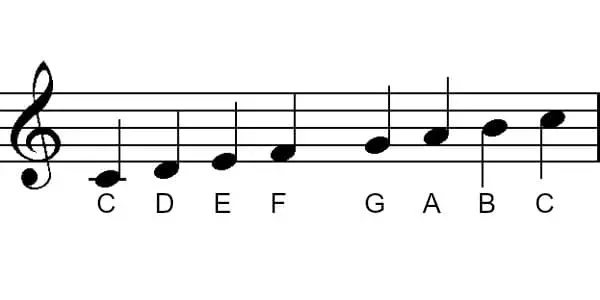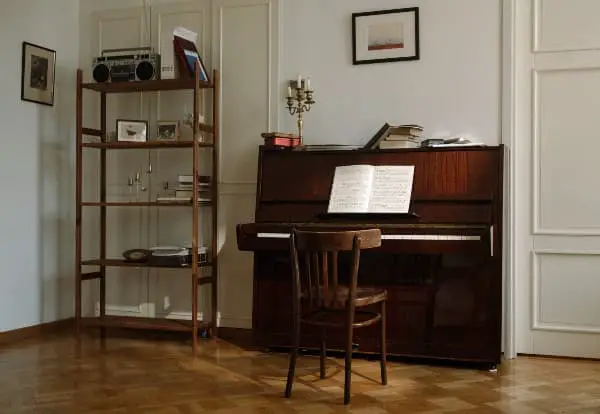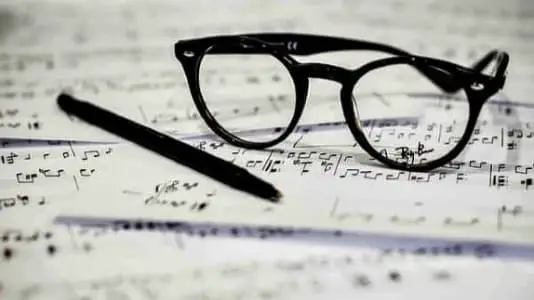- Home
- Learn to Read Music
- How to Read Music Notes
How to Read Music Notes
Melody Notes and Rhythm
This article may contain compensated links. Please read the disclosure for more info.
Would you like to learn how to read music notes? Start here by learning how to read and understand the two most fundamental elements of music: Melody and Rhythm.
How To Read Music Notes
It is easier to understand how to read music if you know that music is built from only three basic elements. These basic elements are the foundation of most musical compositions:
1. Melody
2. Rhythm
3. Harmony
But as you begin learning to read notes, it is a good idea to first of all focus on just the melody and the rhythm, as we'll do here.

Melody & Rhythm
Look at this melody by W. A Mozart, it is the main theme from his Symphony Nr. 40 in G minor:

Now, if we remove anything that has to do with rhythm, we’re left with only the pitches:

This shows us the exact musical pitches of the notes, and you can see the melodic outline or how the melody moves up and down.
You can also see two flats at the beginning of the staff showing us the key signature. It tells us the notes that have to be lowered in the melody for the correct G minor “color” in this piece.
If we from the first example do the opposite; take away all that has to do with the melody - we get only the rhythm:

This time you can see only the rhythm and how it is grouped on the beat that the time signature also tells us at the start (4/4).
As you learn how to read music notes, it's a good idea to first focus on learning and understanding each element separately. Then combine melody and rhythm for a complete melody.
Trouble With Note Reading?
You need to use at least one, or preferably two, tools for this:
- Your voice
- Your Instrument
Let’s take a closer look how you can learn to read melody and rhythm easily!
How to Read a Melody
Did you know that a melody only can move in three ways, apart from up and down? A melody can move by:
- Steps
- Skips
- Repeated Notes
A melody moving by steps is simply moving up or down from space to line to space to line…:

A melody moving in skips or leaps, skips a step or more (could also be called leaps). These skips or leaps are also called intervals:

The final way for the melody to move is not to move at all (!). Repeated notes are just repeating the same note:

To compose a melody with only one of these ways of movement would not be so interesting. Most melodies use at least two, and usually all three ways.
Look at this famous little tune by Beethoven; it is the theme from his 9th Symphony “Ode to joy” using only steps and repeats:

Recommended Resources
- How to Read Music in 30 Days: Music Theory for Beginners
- Sight Reading and Rhythm Every Day
- Learning to Read Music
- Alfred's Essential Music Theory
Musical Scales
To read a melody, it helps to know about the three ways it can move. But it is also a good idea to know what music scale the melody is made from. Each scale consists of a row of notes with a specific distance (interval) between each note.
Identifying what scale the melody is made up from, is helpful when reading notes since you will know exactly how big each step/interval is supposed to be.
In western music notation, the smallest step from one note to the next is called a semitone, or a half-step. The step from a white to a black key next to it on a piano, for example.
The "normal" step is a whole-tone or two semitones. Like from a white key to the next on a piano with a black key in between.
A musical scale is made up of a specific pattern of whole and semitones.
This pattern is what decides what notes need to be changed (lowered or raised). Like in the example above, there were two flats, since a G minor scale uses two lowered notes, the B flat, and the E flat.
Intervals
Musical Intervals are the skips or leaps between notes or the distance from one note to the next.
It helps if you practice how to sing or play intervals when learning how to read music notes so that you can feel exactly how big each skip or leap is supposed to be.
Solfège syllables
When practicing how to read music notes without an instrument, you can use your voice. The most effective way to practice melody reading this way is if you use solfège syllables.
Solfège is a sight-singing technique (used in different ways in different countries) that helps you to become better at singing by sight, but also to improve ear training and note reading.
The Solfège syllables used are Do, Re, Mi, Fa, Sol, La and Si or Ti.
If we use the Mozart example again, focusing on the pitches, we can sing the note names (observe that E and B are lowered a 1/2 step from the two flat(b) signs in the start.) like this: Eb D D Eb D D Eb D D Bb..etc.
Or when using Solfège syllables with the "fixed Do system": Mib Re Re Mib Re Re Mib Re Re Sib...etc.

How to Read Rhythm
After you've learned how to read music notes by playing or singing different pitches; up or down in steps, skips, or repeats, it is time to take a closer look at the rhythm of the music.
Rhythm is the combination of notes and rests in patterns of long and short sounds and silences.
Beat
All rhythm is based on beat.
The steady beat is the pulse you can feel in music but not always hear! It is what you would move or dance to. All rhythm is based on this beat.
The beat is also what decides how fast or slow a piece is. A metronome is a great gadget to help you keep a steady beat, but you can also use your foot or hand to lightly tap or stamp the beat as you learn the rhythm patterns.
Rhythm Syllables
One of the easiest ways to learn how to read music notes and rhythm is to use rhythm syllables. Rhythm syllables are short syllables sounding the different notes and groups of notes.
For example:
- (Sh)= is a rest of one beat.
- Ta = is a quarter note.
- Ta-ka = are two eight notes.
- / = only indicates the bar line.
If we use Mozart again and translate the rhythm to rhythm syllables, it would sound like this:
(Sh-Sh)(Sh) Ta-ka / Ta Ta-ka Ta Ta-ka / Ta Ta (Sh) Ta-ka/ Ta Ta-ka Ta Ta-ka / Ta Ta ...etc.

Summary
To learn how to read music notes easily:
- Start by focusing on the melody one part at a time.
- Sing or play each pitch, observe the melodic outline and how the melody moves in steps, skips, and repeats.
- Next, focus on the rhythm. Learn about rhythm syllables for a quick and easy way to learn rhythm patterns.
- Say, clap or tap the rhythm of the piece, one small part at a time.
- Finally, combine the rhythm and melody by singing or playing it.
Learning how to read music notes is easy. Just remember to begin with short and simple examples. Then gradually build up the difficulty, step by baby step, as your confidence grows.
One Layer at a Time...
Penn & Teller made a great series of educational music videos called "Behind the Scenes" that I have used a lot in my music classes. Here is a fun part talking about musical layers that all make up the whole!
Recommended Resources
- How to Read Music in 30 Days: Music Theory for Beginners
- Sight Reading and Rhythm Every Day
- Learning to Read Music
- Alfred's Essential Music Theory





